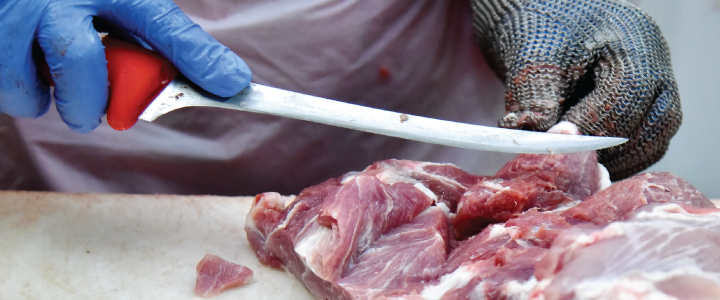Types Of Knives And Their Benefits
The butcher’s knife is an important part of his/her itinerary. Almost a constant presence in their hands; the Butchers skilfully manipulate meat into the cuts and joints that their customers want. The tools are just as important as the quality of meat and the skills present in creating high quality produce.
Even the most experienced and skilled of butchers will struggle to help a cut of meat reach its potential without high quality tools. There is a wide range of different butcher’s knives, here is a list of the most common and prevalent knives and their uses.
Breaking Knife
Alongside the cleaver, the breaking knife is the most heavy duty of the knives in a butcher’s itinerary. Used for the most uncompromising and least delicate of jobs; the breaking knife cuts through flesh and bone with ease. If faced with a large join or full animal carcass; the breaking knife eases its way through to create smaller cuts.
A smaller and weaker knife will make hard work of jobs that the breaking knife will soar through effortlessly. Using a smaller knife is slow, hard work that can be tiresome and potentially dangerous. Hacking away with a smaller knife can lead to rough, poor cuts. Furthermore, the use of a smaller knife can be very frustrating and can lead to hazardous irrational actions.
Boning Knife
Smaller in size that the breaking knife; the boning knife is used for more intricate jobs. Not strong enough to break through large bones; the Boning Knife is used to cut the meat around the bone.
Perfect for intricately extracting cuts of meat such as fillets from the body of an animal. The boning knife has a slight curve to its blade which allows it to effortlessly reach around bones and extract the valuable flesh.
Scimitar Knife
The smallest of the three and probably the most commonly used by a butcher; the scimitar knife is used for the chopping of meat into accurately sized cuts and joints. Incredibly sharp; the scimitar knife can quickly and accurately create many cuts from one piece of meat.
The scimitar knife is most likely to be found in the hand of a butcher when you enter his/her shop. The curved blade of the scimitar knife allows for safe cutting at pace. By resting the palm against the back of the blade to position incisions accurately; a Butcher can cut a piece in meat quickly without compromising the safety of his/her fingers.




